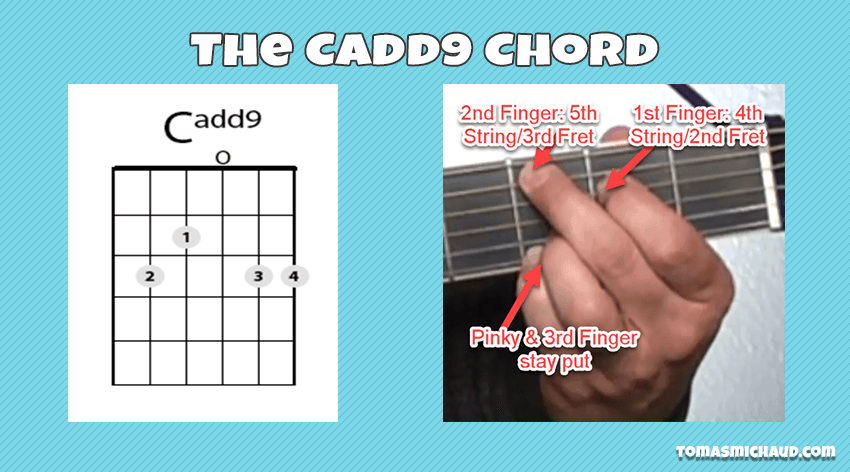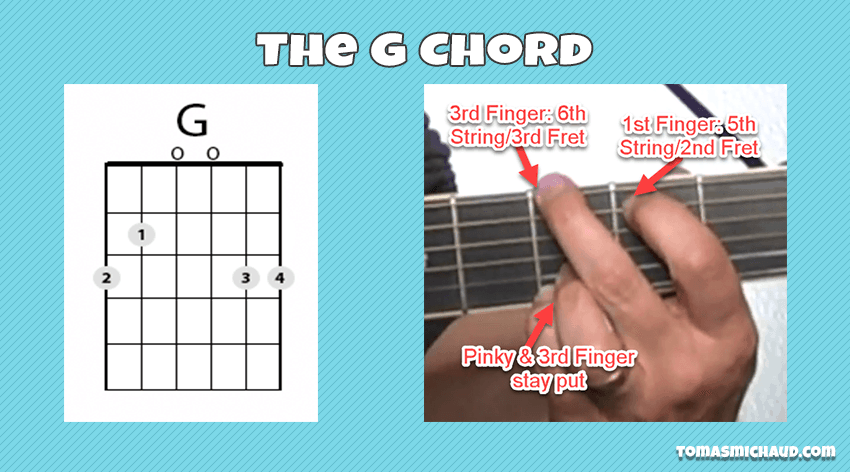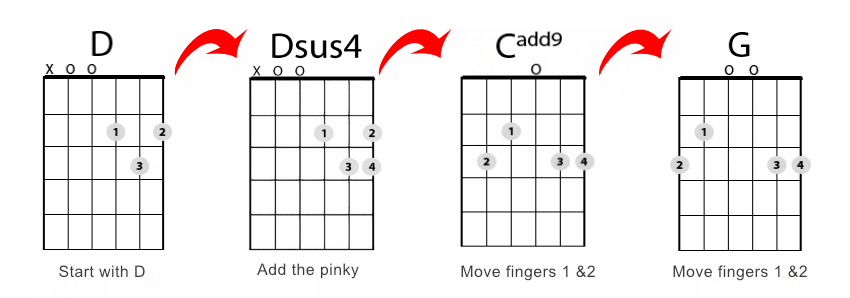Time to learn two more chords!
In the last lesson you learned the D chord. You also learned a method to memorize where to put your fingers and how to practice. In this lesson we will be using the same approach in learning these next two guitar chords – the beautiful Cadd9 chord (we’ll call it just “C” for now) and the G chord.
Why Learn the Cadd9 Guitar Chord?
This is hands down the most beautiful guitar chord in the open position.
Why learn Cadd9 instead of the plain ol' C chord?
Glad you asked. Like many teachers I used to teach the C chord first and chords with fancy names like “Cadd9” much later. But over the years I changed my mind.
Here's why:
- The C chord and the Cadd9 chord are just about the same difficulty.
- The Cadd9 does include the pinky (which you might say makes it more difficult). I've found when taught in this particular order most students are able to include the pinky without much trouble.
- It's easier to move from D to Cadd9. The C chord involves a complete change-up of the fingers.
- From the Cadd9 to the G chord is a breeze… and it opens up lots of possibilities learning the G chord early on.
- Finally, but not the least important reason… the Cadd9 chord is a beautiful sounding chord… and really “hip”.
For these reasons we'll start with the Cadd9. For practical purposes I'll often refer to it just as “C” for this beginner lesson series.
Here's Where to Start
The first thing to do is to practice your new C chord in the same way that you practiced the D chord in the previous lesson.
Do you remember the system?
First finger the chord, adjust, take your hand off, repeat…
Then repeat with plucking the chord.
If you need a refresher go to the previous lesson and substitute “C chord” for everywhere you see “D Chord”.
Once you've done that go on to practicing changing from the D chord to the C chord and back.
Phase 3 – Changing Chords
Now , while still holding the D chord, put your little finger down on the 1st string/3rd fret. The little finger will usually be weak, but when you put it next to the third finger, it will have a little more support. This is in preparation for making the C chord.
Your next move is to move your second finger over to the 5th string/3rd fret. At the same time move the first finger over to the 4th string/2nd fret (aren't you glad you know the fret and string numbers?). Technically it’s called the Cadd9… but we’ll refer to this chord as C for now.
While doing this try the best you can to get your hands hanging perpendicular to the guitar;
and the back of your palm directly facing the ground.
The idea is to relax. It’s not about exerting a lot of pressure on the chord. Many people put more tension in the beginning than it is needed. As you continue practicing you’ll learn to properly adjust your hand and reduce undue pressure.
At this stage don’t worry about the sound.
Now, remove your fingers, shake it out a second, and then back to the D chord.
Repeat this same process 3 or 4 times to get accustomed to the movement.

Do you recognize the system from the previous lesson?
Here’s a summary (from the D chord):
- Enter your text here...Put the little finger down on the 1st string/3rd fret
- Second finger to the 5th string/3rd fret
- First finger to the 4th string/2nd fret
- The pinky and 3rd finger stay put
Now, after practicing the movement several times, try it to see how it sounds. Sounds good, right? Didn’t sound right? No worries, it’s normal. You don’t have to get it the first time (or second, or third…). Just keep practicing a little each day along with…
In the next section you learn what might arguably be considered the most used open guitar chord… the G chord. By itself many students find it challenging, but moving from the Cadd9 chord you'll find it an easy movement. In addition as you practice the G chord it will make the Cadd9 chord easier.
Moving on to…
The Famous G Chord
This is not based on official statistics, but if I had to pick one open chord that I use the most it would very likely be that G guitar chord.
At this point you'll likely find this chord easier to finger. It is definitely much easier moving from the C chord then it would be making it from scratch.
Let’s check it out…
We'll be starting from the C chord. It's okay if you want to make the D chord and then moved to the C chord.
Now, take the first and second finger over to the sixth and fifth string respectively.
That’s 2nd finger to the 6th string/3rd fret, 1st finger to the 5th string/2nd fret.
You can try moving over one finger at a time, but from my experience it's easier to move both at once.
That’s a G chord on guitar.
Here’s a summary (from the C chord):

- Second finger to the 6th string/3rd fret
- First finger to the 5th string/2nd fret
- The pinky and 3rd finger stay put
That’s the C chord.
Now move the first and second fingers again…
- Second finger to the 6th string/3rd fret
- First finger to the 5th string/2nd fret
- The pinky and 3rd finger stay put
That’s the G chord.
Now go back to the D chord. That’s the complete move (progression).
Practice that again and again. Learn to move both fingers at the same time.

What’s Next?
After you practice moving from one chord to another in your left hand, try strumming the chord with your right hand each time you make the new chord.
At first it may not sound great. Take just a few seconds to move the fingers around in the left hand. Keep in mind the principles you’ve learned in the earlier lesson #7 First Guitar Chords to get a better sound. Then move on to the next chord.
In the next lesson I will be sharing some useful tips on how to change from one chord to another more easily and add some strumming to what you’ve learnt.
>>Lesson #9 Strumming Guitar and Changing Chords
Tell Us What You Think - Please Comment Below!
We would love to hear your comments and questions. What specific things are you struggling with while learning guitar?

I’ve been playing the guitar off and on few a few years started taking lessons once and didn’t learn anything so just give up on finding someone I could trust to learn something from asked once someone that runs the ohio valley opry here in are home town if I could sit on there practice sessions to maybe pick up on some things and learn play with other people there answer was flat out no we only take seasoned players and that really left me with a very bad taste in my mouth with ever asking any body for help again so I just learned what could on my own but the desire to lean is what keeps me driven on I live in a very small town forty miles from any bigger cities to actually consider a teacher but I discovered Thomas Michaud while surfing the internet boy was I surprised at what you offered for lessons blew me away this is what I needed you offer up what I need to really help me along the path of my guitar playing future. My wife and I spent a week in Nashville and was I ever so happy when I got to walk up on the stage at the Ryman Auditorium stage it was a dream come true for me that day. That experience made my desire even stronger to want to play music no matter where it may take me in the future. The lessons are what I need to help me with some frustrations I’ve been encountering Thanks Thomas your gonna be a great big help.
Thanks for the comment, Jeff. I’m glad I could help. -Tomas
You are quite diferent from others! You go isto the details and i am quite entusiastic. Thank you! What means “Cadd9”? Are there any good explanation?!
1- why that chord name Cadd9 or Dsus9
2- what the difference between major chord and minor chord w, why in some major chords we put a # sign before note
I’ve only been playing a couple of months, but have learned so much from these lessons. Thank you, Thomas! Was having a lot of trouble going from C to a full G chord, but this lesson helped with that a LOT, because of the position of the fingers in the Cadd9 position. Will be working on this!
I still use these forms of G and C all the time. You may want to try using them with simple songs like happy birthday. It’s good practice. -Tomas
HI Wayne here to say you sound like you mean teaching!Most people say you can learn in few week.bull,I’am 70 year and slow I need to learn chords first and you are the first person to explain thing in realty and understand beginners Thank You I am on D.Cadd9 and G
I've been enjoying the lessons for grown ups up to now. Seriously thinking of continuing, but want to finish this series first. Where is link to lesson #10?
Hi Paula. Here’s lesson #10 https://tomasmichaud.com/fingerstyle-guitar-easy
– Tomas
Hi Thomas I’m 85 been learning for a couple of years. One of the most annoying things for me is being taught to play a cord or a sequence and the being told :-OR YOU COULD DO IT THIS WAY OR THIS WAY This adds to frustration and I find it best to learn one basic way -with one basic teacher and stick to it at least until I have a sound grasp of the basics
I congratulate you on your approach your teaching method and the simplicity of your teaching method
Thank you. Jim. Devon EnglandJim
Hi Tomas:
Are the first and second fingers on the Dsus4 chord in the D-Dsus4-Cadd9-G chord progression figure correct? I thought you add the pinky to D and leave first and second fingers as in D. Figure shows them switched from D.
V/R
BG
Wow… you’re right BG. I don’t know how I did that. I just fixed it. Thanks!
Brilliant !!! So enjoyable trying to play along with Tomas on the very basic stuff
The G – Cadd9 chord progression is a beautiful chord progression, with the gorgeous drone of the “top” three strings (which, from your point of view, are under the lower strings, but they’re called the top strings), while the other three change (generally trying to mute the sixth on the Cadd9). Used in songs such as Every Rose Has its Thorn (which also includes a beautiful-sounding 12-string acoustic guitar).